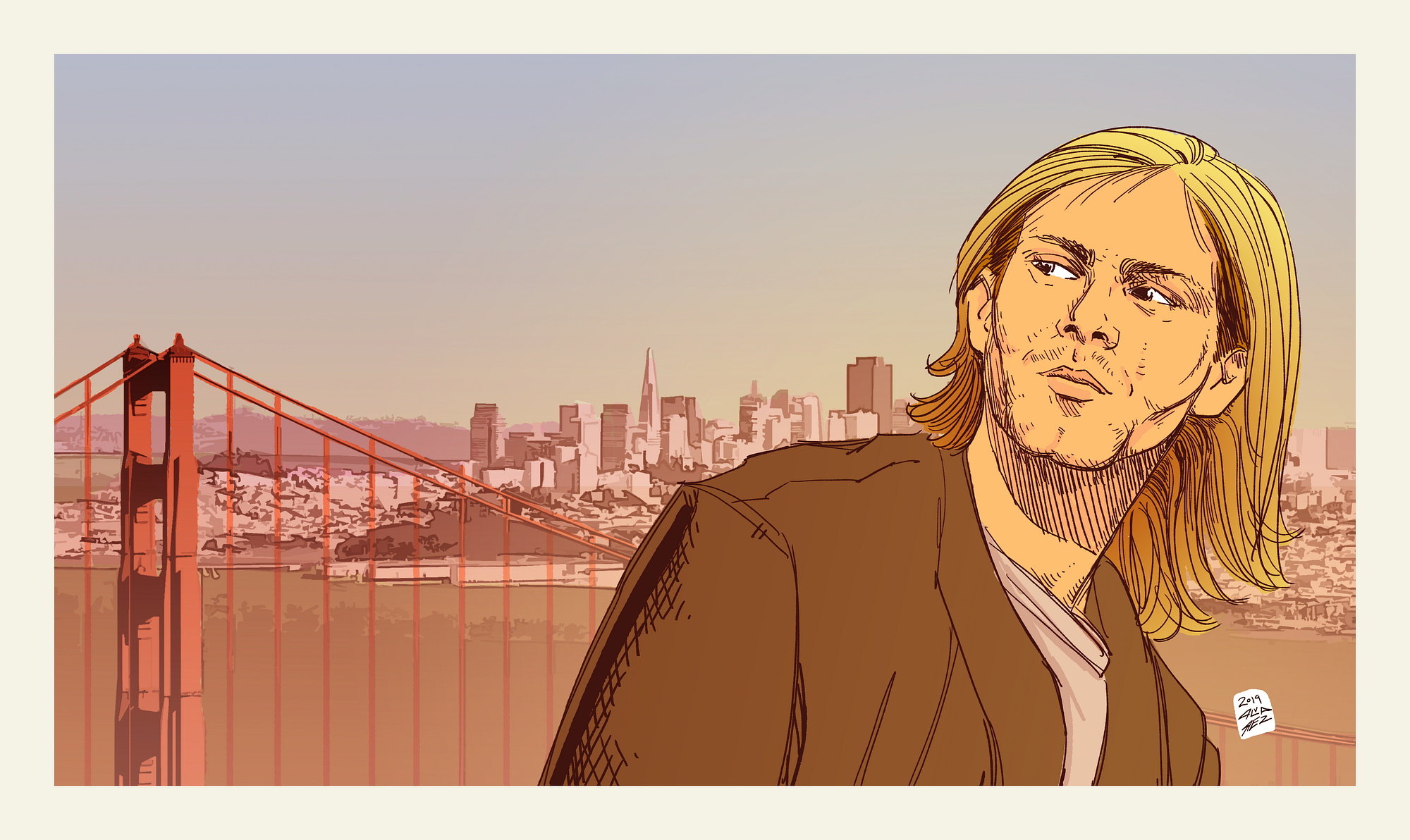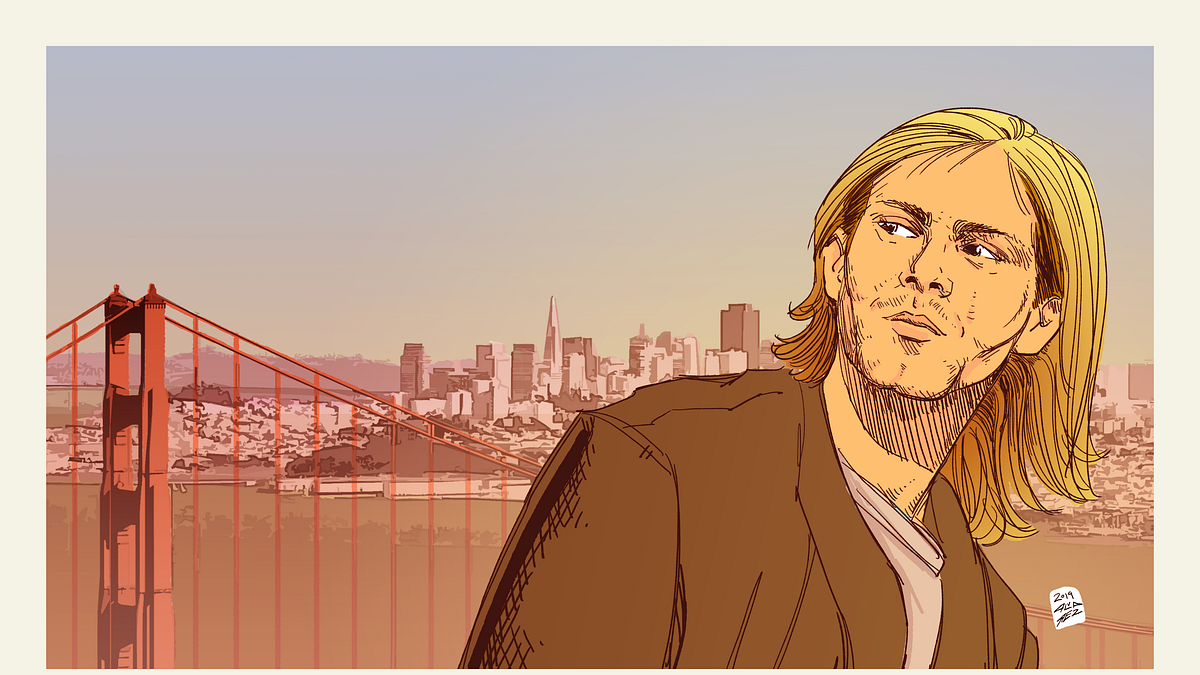
When I picture Kurt Cobain, I imagine him bumming around the bleak logging towns in Grays Harbor, Washington (where he and I grew up), and hanging out in dive bars in Olympia and Seattle. I have a harder time picturing him in sunny San Francisco but know that he hung out here often, playing shows with local bands and talking about Kerouac and Burroughs with Bay Area creatives.
One of those creatives was Frank Andrick, a San Francisco DJ, radio host, and poet who was friends with Cobain in the early days of Nirvana, in the late ’80s and early ’90s. Recently, I chatted with Andrick, swapping stories about Cobain. I told him my personal “insider” story, which usually can’t be topped. When I was growing up in Montesano, Washington, right outside of his hometown of Aberdeen, I had a few of the same teachers as Cobain. In particular, my seventh-grade history teacher, Mr. Winbeckler, would tell the story about how every year, he did the same lesson on Eastern religions. “And it was from this same lesson,” he said proudly, “that Kurt Cobain got the name for his band—Nirvana.”
Andrick appreciated my anecdote, but there was no question about who had the better Kurt Cobain story. It turned out that while DJ’ing in San Francisco in the ’80s and working with A&M Records, Andrick had become friends with a Sub Pop merchandiser and a national-radio promotion person — both of whom were friends with the band. Andrick went to “probably a dozen” Nirvana shows in Seattle and San Francisco. And, he said casually, “It was still possible to just talk to people back in those days.” So he came to know Cobain quite well and even hung out with him a number of times before and after his shows in SF.
This sounded almost too incredible to believe, but Andrick had the proof. In 1991, just after Nevermind hit, Frank interviewed Cobain following the Nirvana show at the Warfield. That album quickly became one of the best-selling and most influential records of all time. Nirvana was suddenly the biggest band on earth, and Cobain was its leader. You can still find that interview online. It’s a great interview, but I had to get the full story to gain insight about an icon and how he spent time in the city I now call home. I reconnected with Andrick to find out the details: What was it like to hang out with Kurt Cobain in San Francisco? What did he think of the city, its bands, and its culture?
Cobain loved the history of San Francisco and was drawn to the myth of the city’s freedom.
Twenty-eight years have passed since Andrick last spent time with the newly minted god of grunge rock, but he remembers many of the details vividly and was happy to answer all my questions.
Nirvana frequently played at a club on Divisadero where Andrick DJ’d. “Kurt had stomach problems,” Andrick explained, “and after sound checks, he would come to my house on Oak Street to rest out, smoke pot, and relax — and be close to the venue for show time. The best Divisadero show I remember was Nirvana, Mudhoney, and Tad as the bill. Rockin’.”
I asked Andrick if he knew at the time that he was hanging out with a cultural icon.
“It was like hanging out with anyone else who is intelligent, bright, a good conversationalist. Sometimes smiley and kind, sometimes depressed and sad about the state of things,” Andrick told me. “We just hung out, talked, and smoked pot. We shared writing and read to each other like I do with my friends now…we had good times.”
Andrick mentioned that Cobain loved the history of San Francisco and was drawn to the myth of the city’s freedom. “SF was still wide open then,” said Andrick. “You could be anything you wanted, and it was cool. Kurt fit in because he did not fit in. All of us found comfortable ‘tribes.’”
As a musician, Cobain was particularly interested in SF bands and music venues. But he was also into “the ideas of hippies, the philosophy of hippies, and spiritual growth and evolution.”
Cobain responded, “What’s alternative? What’s counterculture? What’s cool? Who knows? Who cares?”
I asked Andrick if Cobain had mentioned the Beats, remembering that he had once collaborated with William S. Burroughs.
“Yes, especially the Beats and the mystique about them…He was also drawn to City Lights,” Andrick told me. “I spent some time turning him onto Philip Lamantia, but he was well versed in Ginsberg, Mr. K. [Kerouac], Ferlinghetti, etc.” As Andrick mused, “I could see him doing a spoken word with a sound thing at City Lights. His record with Burroughs—the spoken-word piece ‘The Priest They Called Him’—was just the start…and then he died.”
I wanted to know more about the specifics of the night when Andrick interviewed Cobain.
“It was at a club closed for the occasion on lower Potrero Hill following Nirvana’s triumphant first headlining at the Warfield with Hole,” he told me. “It was also the night following Bill Graham’s death. For me and my friends, all the drinks were free, and everyone was already drunk by the time we got to the party. At the party, a drunk Kurt yelled at a drunk me that we should do the interview now before we became unable to speak. It was a good idea. We found a booth, a pitcher of beer—and that’s how the interview happened.”
Sitting in that booth, at a party in Potrero Hill, Andrick asked, “Do you still see yourselves as an ‘alternative,’ underground band?”
Cobain responded, “What’s alternative? What’s counterculture? What’s cool? Who knows? Who cares? If chasing cool is important to you, you’re an idiot.”
“I do sometimes wonder what a conversation would be like now,” Andrick said to me, 28 years after that interview. He reflected on how the city has changed: “In SF, the club live-music scene…it’s just not the same. I remember it being open and accepting and also snobby and too trendy for its own good. And all that was good. Also, there were very important gay, lesbian, omnisexual, leather punk, suburban kid, jeans-and-sport-jacket elements…and outre artists, body sculpturists, Bowiesque thin white suits, street urchins. Everybody was in as long as you were out. Inclusionists without trying. That’s honest and real, and that was also Nirvana. Beautiful, but with scars too.”







